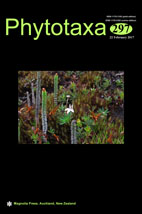Abstract
A molecular phylogeny of the genus Echinops (Asteraceae, Cardueae) based on plastid and nuclear markers is presented. The study focuses on the Iranian representatives of the genus, which constitute a larger part of Echinops. The Bayesian cpDNA tree resulted in a large polytomy. However, the Bayesian ITS tree displayed a well-resolved topology more compatible with the taxonomic treatment generally accepted in Echinops. An ITS network illustrates a close relationship of haplotypes. Mapping diagnostic morphological characters onto the ITS tree revealed a high level of homoplasy among the studied taxa. Except for the life cycle, all other morphological characters evolved many times among the clades and most of them appeared to be of low taxonomical value. Based on the nucleotide polymorphism and haplotypes, the taxonomic status of some taxa was evaluated. The independent status of E. sect. Phaeochaete was confirmed by molecular analyses and morphological characters. The paraphyletic nature of E. sect. Echinops was confirmed. As for the molecular dating, our results suggest that the genus evolved in the early Miocene but the main speciation events took place in the Pliocene-Pleistocene. The biogeographic results do not support any specific ancestral area for Echinops, yet the model states that its current diversity originated in the Irano-Turanian Region and the Eastern Mediterranean region. Some taxonomic changes are suggested, in the synonymy and placement of some taxa.

